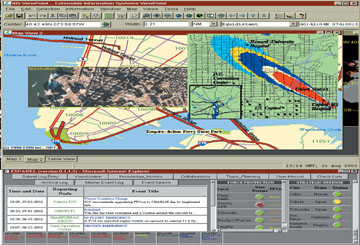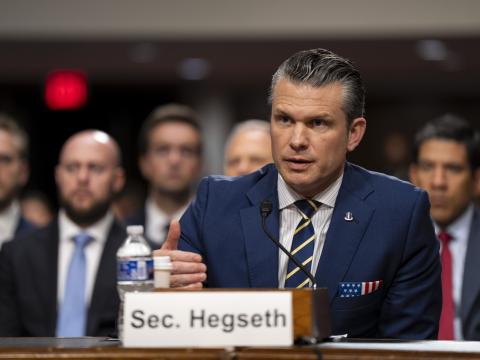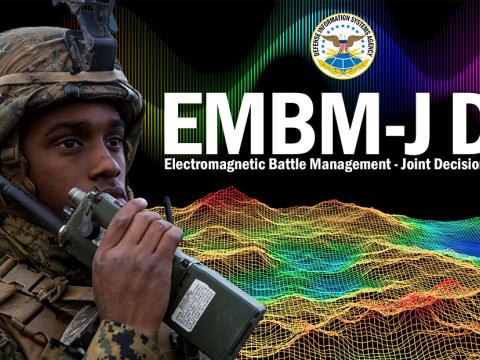Global Command and Control Rebooted
 |
The Global Command and Control System–Joint (GCCS-J) is a set of software tools and applications designed to support commanders at the operational level. GCCS-J allows commanders to plan and manage the movement of troops and equipment into and across theaters of operation, filter sensor feeds and gather battlefield data to build an operational picture for enhanced situational awareness. |
Upgrades to a major command and control system soon will provide
The Global Command and Control System–Joint (GCCS-J) is designed to support high-echelon decision makers. The system provides an integrated, real-time picture of the battlespace to support joint and multinational operations, explains Brig. Gen. Peter F. Hoene, USAF, GCCS-J program executive officer, Defense Information Systems Agency (DISA),
Gen. Hoene explains that the major difference between the upgrade to GCCS-J, known as Block V, and the current Block IV is that the new system is migrating away from the common operating environment (COE) kernel that had been the basis of all Block IV and previous development. “Migrating away from that allows us a more robust ability to use commercial products and third-party applications that previously would have been difficult to integrate within that common operating environment framework,” he says.
The general maintains that Block V also represents DISA’s movement to a more network-centric capability for GCCS-J because the previous COE featured tightly connected interfaces and a client-server computing environment that were difficult to shift to a service-oriented architecture. He explains that by breaking away from the old COE and creating a set of Web and information services under Block V, DISA will be more flexible in its ability to add new services, tools and applications to the network.
The new, enhanced service provided by the Block V upgrade to GCCS-J also highlights the possibility of future capabilities. The Defense Department has long-term plans to transition from the GCCS family of systems to the future joint command and control capability (JC2C). Gen. Hoene maintains that JC2C is not a DISA-specific concept, but an idea that was jointly developed by the services, DISA, the Office of the Assistant Secretary of Defense/Network and Information Integration, and Joint Forces Command. “There are numerous C2 capabilities in use today that are only available to a limited set of users, perhaps only a single user organization. We, meaning the services and components, will work to make those capabilities available to the Defense Department enterprise,” he says.
The GCCS-J offers a starting point for migration to JC2C, Gen. Hoene contends. He adds that some functions within this group of systems are best adapted for use as enterprise services. To provide functionality, DISA will create an adapter or bridge, a Web front end that will make applications searchable and available to users while using current code as a back-end component. Creating new software is the least preferable approach to modernization, the general says. However, he notes that parts of current systems are at the end of their useful lives and that rewriting them as modernized services is the most effective and efficient approach.
The Defense Department’s operational goal for JC2C is to provide capabilities to warfighters in a faster, more agile manner. To achieve this goal, the department will leverage technology investments it has made in a variety of programs and initiatives by bringing them together in a service-oriented architecture. For example, Gen. Hoene notes that components of the Net-Enabled Command Capability program, which did not meet its developmental goals and is being cancelled, will be transitioned back to GCCS-J to build future capabilities. In three to five years, he hopes, many legacy applications used by the services and agencies will be transformed to loosely coupled software applications made available at the enterprise level to support users across all echelons.
The GCCS-J connects warfighters to the systems used to plan, execute and manage military operations. It consists of three sections or baselines: Global, which focuses on situational awareness and intelligence; force protection, which consists of the Joint Operation Planning and Execution System (JOPES); and force readiness, which is supported by the Status of Resources and Training System (SORTS). Gen. Hoene notes that Block V successfully passed a final deployment decision review on August 28, 2009. This final approval also officially defined Block V as closed, meaning that DISA has completed all of the development activities for the latest versions of Global, JOPES and SORTS. The Block V upgrades are scheduled for completion by the end of 2009.
Among the enhancements provided to GCCS-J under Block V is the ability for the Global component to filter and display up to 100,000 tracks. The Global part of GCCS-J provides a common operating picture displaying mission track information over a map background. It is unlikely that users will display all 100,000 tracks simultaneously on their operational screens, Gen. Hoene observes. However, this information resides in a database for reference and to support ongoing operations. The ability to store and display this many operational tracks is a major improvement over previous versions of GCCS-J. “You can have all that track data and filter it according to your needs as a combatant commander,” he says.
Another upgraded part of Global is the integrated imagery and intelligence component, known as I Cubed. The imagery function provides near-real-time intelligence data to enhance combatant and component commanders’ situational awareness. For example, forces in combat in
Additional enhancements provided through the Block V Global baseline include an improved ability to determine the effects of nuclear, biological and chemical attacks; combining imagery objects with metadata on a common operating picture; integrated alert notifications; new intelligence tools; and intelligence data, graphics and imagery displays provided via a Web browser. Block V also integrates new information operations/information warfare planning tools; allows planners to build time-critical targeting folders from a common operating picture/intelligence display; to generate target quality coordinates from sensor images; and to share tracks, imagery and data across different security domains.
JOPES is the second major component of GCCS-J. It is a suite of applications designed to allow commanders to plan major movements of troops and equipment into and around a theater of operations. JOPES incorporates policies, procedures, personnel and facilities by interfacing with automated data processing (ADP) systems, reporting systems and underlying GCCS ADP support to provide decision makers and their staffs with the ability to plan joint military operations.
Fielded as a strategic server enclave at four locations, JOPES supports users worldwide by providing authorized subscribers with access to its suite of applications. Under Block V, upgrades to JOPES include maintaining the core client/server applications required for stable and secure access to critical operational planning data. Additional improvements include the introduction of Web-based applications, updating systems with the latest commercial software releases and the continued deployment of software as services to military customers.
The final component of GCCS-J is SORTS, which is an integrated, automated reporting and assessment tool set for providing the readiness information necessary to make resource allocation and force commitment recommendations to decision makers. SORTS is the single automated reporting system within the Defense Department that provides commanders with identification, location, assignment, personnel and equipment data. The general notes that this information covers everything from a unit’s manpower levels, to its training and support equipment.
SORTS is fielded as a strategic server enclave with a primary and backup location supporting users worldwide. Major accomplishments under Block V include an update to the SORTS security posture with the issuance of a three-year authority to operate and the introduction of a Joint Tool that provides automated registration and reporting on joint units. Other improvements include upgrading the Solaris 10 and Oracle 11 software suites to enhance interoperability with other systems; an upgraded forces display to summarize units by combatant command that allows users to drill down to access individual assigned units; and a tiered readiness reporting and analysis capability for forces at the strategic, operational and tactical levels.
Rather than deploying simultaneously, each of the GCCS-J components is being fielded separately under the Block V upgrade. The new Global component is being installed at 53 sites worldwide. A DISA team will be working for the next year to stand up the new Global applications at the sites. According to Kim Rice, deputy program manager for GCCS-J, the work requires coordination with each site’s system administrator and includes building the suite and providing system administrator training. “We don’t do drive-by fieldings and just leave it there for them [site personnel] to figure out. We also incorporated all the administrative duties and tasks that we recommend the sites perform to maximize their server configurations on the ground,” she says.
Because JOPES and SORTS reside in strategic server enclaves, DISA plans to upgrade them at their locations by the end of this calendar year. The
WEB RESOURCE
Global Command and Control System–Joint: www.disa.mil/gccs-j/




Comments